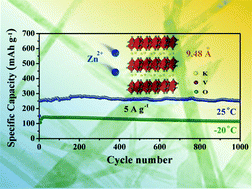Tuning the electronic structure of layered vanadium pentoxide by pre-intercalation of potassium ions for superior room/low-temperature aqueous zinc-ion batteries†
Abstract
Aqueous zinc-ion batteries (ZIBs), due to their sluggish Zn2+ diffusion kinetics, continue to face challenges in terms of achieving superior high rate, long-term cycling and low-temperature properties. Herein, K+ pre-intercalated layered V2O5 (K0.5V2O5) composites with metallic features are capable of delivering excellent zinc storage performance. Specifically, the K0.5V2O5 electrode delivers a high reversible capacity of 251 mA h g−1 at 5 A g−1 after 1000 cycles. Even at a low temperature of −20 °C, high reversible capacities of 241 and 115 mA h g−1 can be obtained after 1000 cycles at 1 and 5 A g−1, respectively. The outstanding electrochemical performance is attributed to the incorporation of K+ into the layered V2O5, which acts as pillars to promote the Zn2+ diffusion and increase the structural stability during cycling. Density functional theory calculations demonstrate that the interlayer doping of K+ can benefit electron migration, and therefore enhance the Zn2+ (de)intercalation kinetics. Meanwhile, the Zn2+ storage mechanism of K0.5V2O5 is revealed by ex situ X-ray diffraction, X-ray photoelectron spectroscopy, scanning electron microscopy and transmission electron microscopy characterization. This work may pave the way for exploiting high-performance cathodes for aqueous ZIBs.

- This article is part of the themed collections: Energy Frontiers: Electrochemistry and Electrochemical Engineering, Nanoscale Horizons and Nanoscale: Nanomaterials for Energy and 2021 Nanoscale HOT Article Collection


 Please wait while we load your content...
Please wait while we load your content...